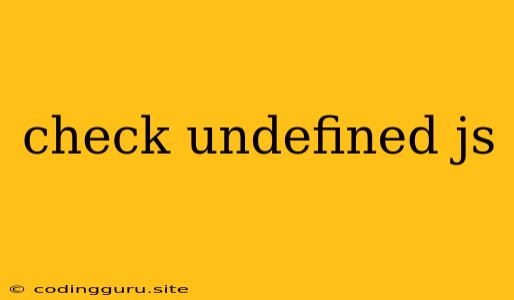Dealing with the "Undefined" Beast in JavaScript
JavaScript, with its dynamic typing, can sometimes lead to unexpected behaviors. One of the most common issues developers encounter is the dreaded "undefined" value. This occurs when a variable or property doesn't have an assigned value, which can cause errors and disrupt your code's functionality. Let's delve into the world of "undefined" in JavaScript, understanding its origin, consequences, and how to effectively manage it.
What is "Undefined" in JavaScript?
In JavaScript, the "undefined" value signifies the absence of a meaningful value for a variable or property. It's not the same as "null", which explicitly indicates an empty value. "Undefined" suggests that a variable has been declared but hasn't been assigned a value yet.
Consider this simple example:
let myVariable;
console.log(myVariable); // Output: undefined
In this case, myVariable has been declared but not initialized. This makes its value "undefined."
Why Does "Undefined" Matter?
You might wonder why "undefined" is such a big deal. Well, it can lead to unexpected results and errors in your code. Here's why:
1. Unexpected Behavior: Operations involving "undefined" values can produce strange results. For instance, attempting to add "undefined" to a number will result in NaN (Not a Number).
2. Errors: Trying to access properties of an "undefined" object will throw a "TypeError" because the object simply doesn't exist.
3. Logic Issues: In conditional statements, "undefined" can disrupt the expected flow of your logic.
How to Handle "Undefined" Values
Dealing with "undefined" effectively is crucial for writing reliable JavaScript code. Here are some common approaches:
1. Check for "Undefined" Using typeof:
The typeof operator is your go-to tool for checking the type of a variable. It's especially handy for detecting "undefined" values.
if (typeof myVariable === 'undefined') {
console.log("myVariable is undefined");
} else {
console.log("myVariable is defined");
}
2. Use Optional Chaining (?.):
This operator provides a concise way to access properties of an object without triggering an error if the object or a nested property is "undefined".
const user = {
name: 'Alice',
address: {
street: 'Main Street'
}
};
console.log(user?.address?.city); // Output: undefined (city property is not defined)
3. Default Values with the Nullish Coalescing Operator (??):
This operator is useful for assigning a default value when a variable is "undefined" or null.
const message = greeting ?? "Hello!";
console.log(message); // Output: "Hello!" (greeting is undefined)
4. Use hasOwnProperty() for Objects:
When dealing with objects, use hasOwnProperty() to check if a specific property exists within the object.
const user = {
name: 'Alice',
age: 30
};
if (user.hasOwnProperty('city')) {
console.log(user.city);
} else {
console.log("The 'city' property doesn't exist");
}
Examples and Best Practices
Let's illustrate these techniques with some code examples:
Example 1: Checking for undefined in a Function Argument:
function greetUser(name) {
if (typeof name === 'undefined') {
name = "Guest"; // Assign default value
}
console.log("Hello, " + name + "!");
}
greetUser(); // Output: Hello, Guest!
greetUser("Bob"); // Output: Hello, Bob!
Example 2: Using Optional Chaining with Nested Objects:
const user = {
name: 'Alice',
address: {
street: 'Main Street'
}
};
const city = user?.address?.city;
if (city) {
console.log("City: " + city);
} else {
console.log("City is not defined");
}
Example 3: Default Value with Nullish Coalescing Operator:
const age = 25;
const greeting = `You are ${age ?? "unknown"} years old.`;
console.log(greeting); // Output: You are 25 years old.
let age2;
const greeting2 = `You are ${age2 ?? "unknown"} years old.`;
console.log(greeting2); // Output: You are unknown years old.
Best Practices:
- Always be mindful of potential "undefined" values: Anticipate scenarios where variables or properties might be "undefined" and implement appropriate handling.
- Use
typeoffor thorough checks: It's a reliable way to determine if a variable is "undefined." - Embrace optional chaining (
?.) and the nullish coalescing operator (??): These operators simplify code and make it more robust.
Conclusion
"Undefined" in JavaScript might seem like a minor nuisance, but it can significantly impact your code's behavior. By understanding its nature and employing appropriate handling strategies, you can write more reliable and predictable JavaScript applications. Always be aware of potential "undefined" values and proactively address them to avoid unexpected errors and ensure your code functions as intended.
